

We've recently established a new category called "Assistant AI." In this category, we will provide artificial intelligences (AIs) that can answer questions about how to use each software and assist with specific tasks.
As the first installment, we are excited to release the "RINEARN Graph 3D Assistant," an AI well-versed in handling our 3D graph software, "RINEARN Graph 3D"!
We'll save the technical background and production details for a later article (Technical Explanation Edition), but for now, let's introduce this Assistant AI and take it for a test drive!
This Assistant AI is available through the web service "ChatGPT" provided by OpenAI in the United States. So, as a prerequisite, let's first talk about ChatGPT.
Now, have you already used ChatGPT?
Many of you might say, "Yes, I'm already using it." If that's the case, feel free to skip this section and proceed to the next.
For those who haven't used it yet or have only heard the name, let's go over it together below!
So, what exactly is "ChatGPT"? It's a service where you can have conversations and ask various questions to an AI.
It can communicate very naturally, almost like a human, and sometimes you may end up having long, casual chats. Moreover, it can freely handle languages from all over the world, whether it's Japanese, English, or any other language.
That's impressive enough, but it gets even better. It's incredibly knowledgeable about a wide range of topics and kindly answers your research questions, making it a reliable companion.

As you can see, it's an amazing service, and anyone can use it for free!
There is also a paid version called "ChatGPT Plus" that offers access to a more advanced AI and allows you to create and publish "customized AIs" like the one we're offering. It also significantly reduces restrictions like the number of questions you can ask per hour (which can be a bit annoying).
However, even the free version is quite powerful, and it can make a big difference in your daily life. Our newly released "RINEARN Graph 3D Assistant" can also be used with a free account.
Note: Free accounts have a limit on the number of questions you can ask within a certain time frame. Once you hit the limit, you'll need to wait a few hours before asking more. ChatGPT Plus members can use it more extensively.
Now, if you'd like to give ChatGPT a try for some casual conversation, all you have to do is access the following page, and you can start chatting right away:
However, without an account, the functionality is quite limited and inconvenient.
By taking a moment to register for a free account, you'll enjoy the following benefits:
So, if you haven't created a ChatGPT account yet, now's the time! Here's how to do it.
Once you've done this, you'll have full access to ChatGPT's features (for free accounts).

You can start a conversation by typing a message in the "Send a message" box at the bottom of the screen. Your conversation history will accumulate as a list in the left-hand column, and you can click on any entry to continue a past conversation.
By clicking the round icon in the top-right corner, you can adjust detailed settings. You can customize the tone and style of responses, manage memory, and more.*
Now, let's get to the main topic of today.
On the ChatGPT platform, you can use "customized AIs" (GPTs) created by various companies and individuals (a paid account is required to create one).
The "RINEARN Graph 3D Assistant," which RINEARN has just released, is one of these customized AIs. It's an AI that helps you use RINEARN's 3D graph software, "RINEARN Graph 3D"!
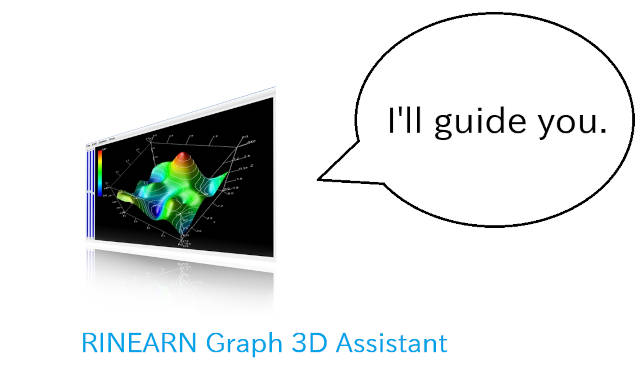
If you've been following the evolution of computers and the internet for a long time, you might be thinking something like this:
Oh, services like those "AI supporters" have been popping up from time to time for ages. What, are those kinds of things trending again?
But those "AI supporters" might seem like they provide decent answers to typical questions, but when you actually try to have a serious conversation about something complex, the dialogue quickly becomes disjointed. Honestly, I can't see them as practicalc
I completely understand where you're coming from -- I've seen my fair share of those kinds of things too. Up until recently, I felt the same way: "It is technically interesting, but..."
However, once I started working on this project, I realized just how much the underlying AI has evolved. It's clear that we've reached a point where this kind of tool is starting to become genuinely practical. You can really feel that we've crossed some major threshold.
At first, this project was just an experiment, but by the end, I realized, "If I had to choose between having it or not, I'd definitely choose to have it." There are so many situations where it would be really helpful. That's why we decided to officially release it this time.
That being said, it's not perfect, and there are still quite a few challenges.
The most troublesome issue is something called "hallucinations." To put it simply:
What makes this especially tricky is that the AI's communication skills are so advanced that it's hard to notice the falsehoods. It's like dealing with a person who speaks very smoothly and confidently, but occasionally slips in a falsehood without you realizing it.
Given the current structure of LLM (Large Language Model)-based AI, it's a phenomenon that's quite difficult to completely prevent. We're doing our best to reduce hallucinations, but they still occasionally occur.
However, saying, "We shouldn't use it because it occasionally provides false information" would be a waste, given how powerful it is in many other areas. I'll share some examples later, but when it does its best, it's incredibly powerful.
For its role as a guide to installing and using 3D graph software, even if it occasionally provides false information, you can ultimately determine that it's incorrect, so the damage is minimal -- maybe just a bit of extra effort. Taking that into account, we weighed the pros and cons and decided to proceed with the release.
So, when using it, we apologize in advance, but please use it with the understanding that hallucinations (false information) may occasionally occur.
If you ever feel like, "Hmm, this answer is clearly wrong...," try asking the following:
It may sound like a joke, but surprisingly, this often results in a more accurate response.
* My guess is that when the AI is asked to recheck, it searches its knowledge again under the assumption that the previous answer was incorrect, which increases the chance of finding the correct information.
Sometimes, it seems that the AI skips properly searching through the knowledge it was trained on and answers based on a guess, which is when hallucinations tend to occur.
Now, let's actually try using it!
You can start using the "RINEARN Graph 3D Assistant" simply by logging into ChatGPT and accessing the following page:

At the bottom of the page, there's an input field labeled "Send a message to RINEARN Graph 3D Assistant," where you can type in your questions to start a conversation.
Unlike the older types of support AIs, this one will do its best to understand your intent, even if you ask in a pretty casual way.
So, there's no need to feel stiff or formal -- think of it like asking a friend sitting next to you for advice, and feel free to ask away!
Alright, let's actually talk to the AI! First, we'll ask it a common, template-like question to introduce the software:
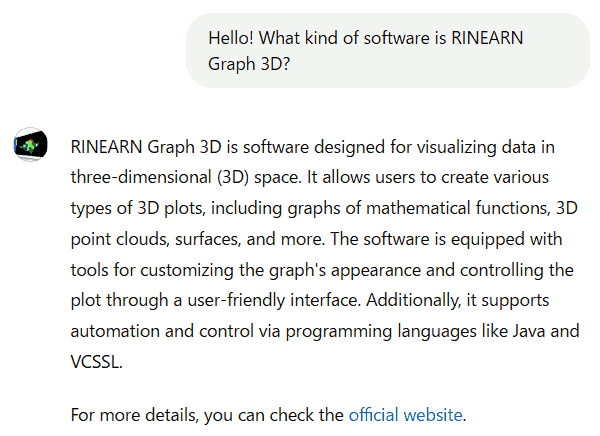
...Well, as expected, it answers this perfectly. I mean, this is like the "Question 1" level of difficulty.
Next, let's continue from the previous conversation and ask how to get and use it:

Overall, this is also a pretty good answer.
However, one characteristic of modern AI (especially LLM-based ones) is that even if you ask the same question multiple times, the response can vary.
So, in these situations where you ask a single question and expect a single answer, there's always a chance of either getting a "hit" with a clear answer or a "miss" with a more confusing one. As mentioned in the previous section, hallucinations can also happen with some probability.
In other words, even modern AI has its accuracy limits, but its conversational ability is quite advanced. That's why it's a good idea to avoid expecting a perfect solution in one shot. Instead, think of it like gplaying conversational catchh and gradually working toward the solution together. For example:

The above error is something that many people encounter when using the software on Windows, so it's actually pretty important. Although it's written in the manual, it seems the AI initially downplayed its importance and left it out in the first response.
The AI tends to keep its responses concise and readable, so sometimes it skips over things (otherwise, you'd get lengthy manual-like responses). But don't worry -- if you ask, it will give you more detailed answers.
Now that we've got the software running, let's ask the assistant how to use it.
First, the very first step -- how to open a data file and plot it:
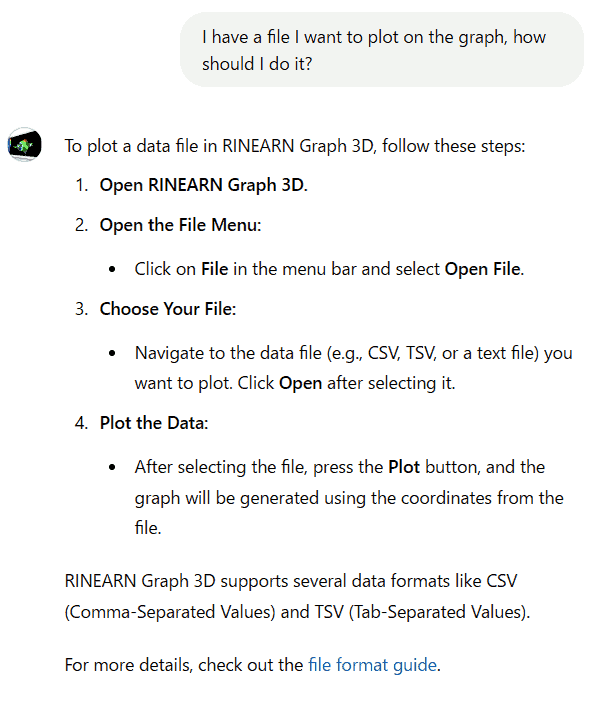
That's pretty much OK. But since the assistant kindly provided a reference page, let's ask for a bit more information.

As shown in this example, it also navigates you to relevant pages in the online user guide!
Next, let's ask a few more questions about the basic functions of the software.
First, let's try asking about plot option settings:

Nice. Let's ask one more:

This is also spot-on.
Now, let's ask about other settings, like the camera angle:
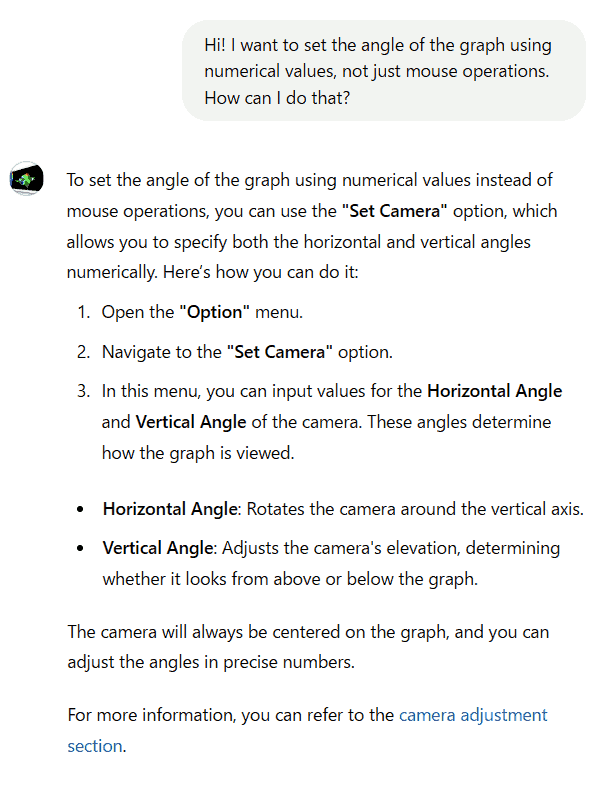
This one's perfect, too!
However, when asking about settings, sometimes the assistant might provide answers using the Java language API (which we'll explain later). In those cases, you can ask:
And the assistant will research and answer again.
There are still moments when things that aren't explicitly stated, but seem like they should be understood without saying, don't get through to the AI. The conversation feels so natural that you tend to assume it'll understand, but sometimes it doesn't.
Now, let's raise the difficulty level a bit.
RINEARN Graph 3D allows programmatic control, which enables the automation of complex tasks. Let's ask about that:

As you can see, it wrote a sample program using "VCSSL," the proprietary scripting language that RINEARN Graph 3D natively supports!
Honestly, I was shocked. When I first tested this, I was blown away -- like, wait, you (AI) can really do that?
By the way, RINEARN Graph 3D doesn't just support VCSSL -- it can also be controlled using Java. Let's ask about that as well:

Impressive. I guess if it can handle the previous task, it's no surprise it can do this too. The ChatGPT AI should have learned a lot about the Java language from information all around the world.
This means that it might be able to work with users to write programs that "perform complex processing in Java and then graph the processed data" to a fairly decent level. Having help with that kind of task could be incredibly useful.
Now, when it comes to programmatic control, it's not just about writing code -- you also need to get used to running it. Let's ask about that:

Everything is spot on. By this point, it's not even surprising anymore.
To wrap up the programming section, let's ask a slightly more abstract, potentially tricky question from a meta perspective:

Oh, that's quite an insightful response.
It's almost exactly how I'd answer that question myself. Although there are probably a few hints in the official documents, I believe this answer is something the AI came up with on its own. It's probably good at this kind of broad analysis as well. Impressive.
Since the conversation has taken a more technical and niche direction, let's continue down that path.
This time, let's ask about the installation process, assuming the user is on Linux rather than Windows:

The instructions for installing RINEARN Graph 3D are accurate, but in the case of Linux, you need to have a Java runtime environment installed beforehand, or it won't work. Let's ask about that:

The guidance is spot on, and this method worked perfectly in my test environment.
When it comes to setting up slightly more complicated environments like this, it seems you often won't get it right on the first try. You'll need to dig deeper through back-and-forth conversations.
However, as you continue the dialogue, you do get closer to the goal. Having an AI assistant around in situations like this definitely feels more reassuring than not. What do you think?
Alright, we're at the final part.
Up to this point, the difficulty of the questions and answers has been ramping up. So, let's go in the opposite direction for the finale. Specifically:
We'll ask the AI to guide us through the installation process of RINEARN Graph 3D, assuming we're that user.
This is actually one of the scenarios I'm really looking forward to with this AI project. That's because when writing a user guide, it's always a challenge to figure out:
There's an inherent trade-off between how detailed the explanation is and how long and overly verbose the text becomes. In practice, you have to draw the line somewhere, and inevitably, there will be a group of people left thinking, "I have no idea what this is talking about." It's just a reality.
But with AI, it can adjust the level of detail for any audience. Ideally, this means it could cover all levels. That's one major difference from a static document, I think.
Of course, that requires a certain level of AI capability. So, how does it perform in its current state? Let's give it a try:

Here's the start of the conversation. This user probably wants to "draw a graph" but has no idea how to go about it. They're at the level of wondering, "Does my computer even have that kind of function?" That's the kind of background I imagined when asking this vague "What should I do?" question.
If I were asked this question, I would probably respond bluntly and confusedly with, "What do you mean?". However, the AI's answer is impressive here -- it creates an atmosphere that makes you want to ask more specific questions. "Let me know a bit more, and I'll be happy to assist!" It's got great communication skills, doesn't it?
And thanks to that atmosphere, the user asks a slightly more specific question:

The next question, "I want to launch it," is still vague, but considering the situation, I thought it would be realistic for the user to not clearly remember the name of the graphing software, so I kept the question casual.
The AI, understanding its role, likely assumed the user wanted to launch RINEARN Graph 3D and asked about the platform to guide them through the installation and launch process. The user responded:
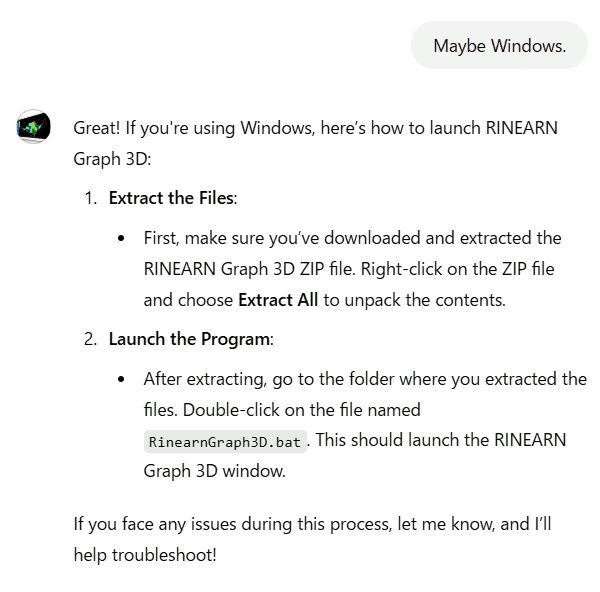
Finally, we reached the explanation on how to launch the software. The instructions are clear, but for someone new to PCs, they might find it difficult to follow. Most likely, they'd get stuck at the first mention of "download."
So, the user asks a follow-up question, "What is download?":
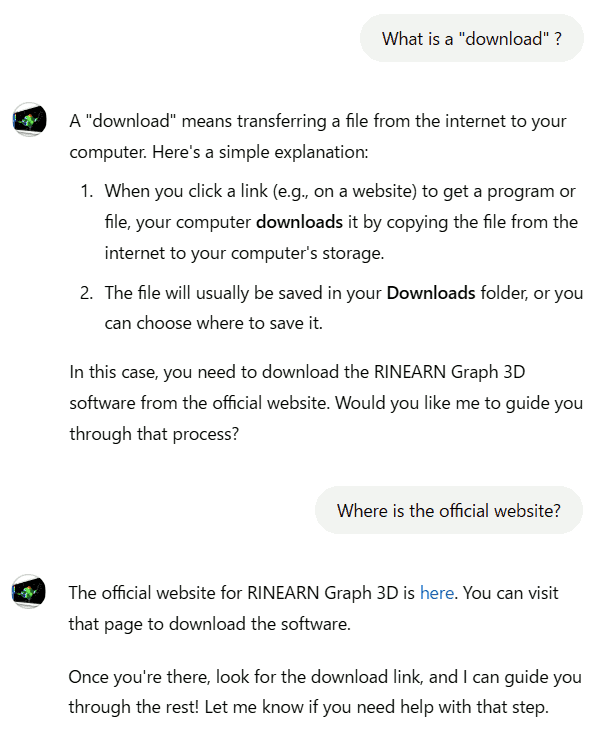
As you can see, the AI explains what "download" means and breaks down where to go and what steps to take to download RINEARN Graph 3D.
Even after successfully downloading, the confusion that seems all too likely continues, but the AI gently and warmly guides the user, sticking with them until they finally reach the point of attempting to launch the software.

After several more follow-up questions, they finally succeed in launching RINEARN Graph 3D!
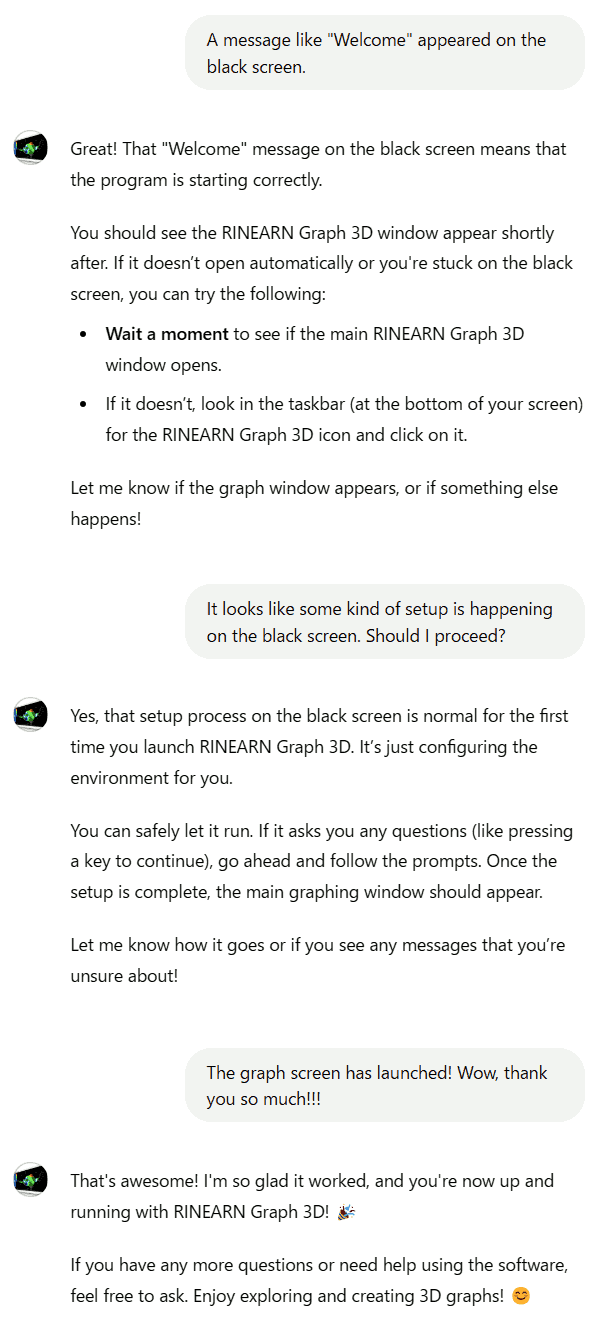
As you can see, after a long back-and-forth, we finally reached the goal. Of course, this was just a simulation (and I'm the one playing the role of the user), so in reality, there would probably be more struggles along the way...
nitially, I planned to keep this article short and simple, but I got a bit carried away with enthusiasm, and it turned out to be a very lengthy read. I apologize for the long, difficult-to-read article.
Looking back at what I've written here, I really feel that there's immense potential in this kind of "AI-driven user guide." While they've existed for some time, it feels like the potential value is finally starting to blossom thanks to the evolution of the underlying AI technology.
The ability to "adjust responses based on the user" is a huge advantage. For those who want to know the details, it can go as deep as needed, and for those who want simplicity, it can be as easy as possible. That's something static documentation simply can't replicate. There are still many challenges to overcome, but I feel it's worth investing the time and technology into it.
Going forward, RINEARN will continue to focus on this project, improving accuracy, expanding the knowledge base, and more. There are still many rough edges, like providing incorrect answers at times, but I'd appreciate it if you could watch over the project with patience and understanding in the long term.
Next time, in the sequel to this article (Technical Edition), we'll take you behind the scenes and show you exactly how we created the "RINEARN Graph 3D Assistant." We'll be sharing everything openly, and you'll see just how easy it is to make one yourself! Let's build one together! Stay tuned!

